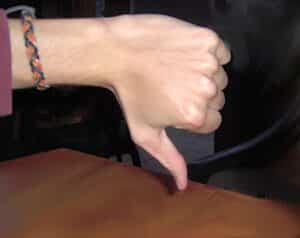Some Binge-Eating Basics | Childhood Obesity News

In the dawning days of civilization, there were different kinds of shelters, various food sources, and many ingenious ways to get hold of edible plant and animal products. The inhabitants of this Colorado cliff dwelling ate rice, maize, pine nuts, squash, beans, seeds, berries, nuts, and roots. Vegetables were sun-dried so they would last. Of course, the residents availed themselves of fish and small game, both of which would have been very difficult and labor-intensive to obtain even in the best weather, let alone when the ground was frozen and covered with snow for months on end.
Our source says, “Food was stored in large pits, often sealed in baskets or pottery for protection from insects, animals and moisture.”
But what about people? If binge eating existed then, that would make it one of the most ancient bad habits on Earth. Also, the earlier in human history it happened, the more serious the infraction would have been. In much of North America, early communities had one thing in common. When cold weather set in, sure, the occasional animal could be caught — but there were no guarantees. There was only a certain amount of stored food, and it had to be enough to last through the winter, for everybody.
One binge-eating episode, committed by one individual, could seriously affect the whole settlement. Of course, a factor in the community’s favor was the difficulty of sneaking food. In long-term storage, few casual munchies would be available. By and large, whatever you hoped to eat would need to be shelled, ground, parched, peeled, chopped, pitted, boiled, or in some other way prepared, as a prerequisite to consumption. This would not be easily accomplished on the down-low. In a small, close-knit population, sneaking food would be difficult, if not impossible.
More modern times
We will review (not in the sense of critical judgment, but in the sense of taking another look at) previous Childhood Obesity News posts that mentioned binge eating. For instance, it is a startling fact that some binge eaters don’t even get fat!
Some “make up for” binges by eating very frugally the rest of the time, to find a crude kind of balance and maintain normal weight. This can backfire — and usually does — because the enforced hunger is just as likely to trigger another binge.
How might you know if your consumption is at binge level?
Do you have episodes of eating a lot in a short time frame? Of eating until you are uncomfortably or even painfully stuffed? Does this happen once or twice a week? Do you hide food, or furtively consume it alone? Do you feel embarrassed and ashamed? Does this habit interfere with other aspects of your life? Do you feel like you just can’t stop, as if you are the pawn of some ungovernable force?
Binge-eating seems to run in families, although that could just be the “monkey-see, monkey-do” effect, rather than anything anatomically genetic. When kids grow up watching parents self-medicate with a particular substance, it should come as no surprise if they continue the family tradition.
Another thing about binge eating is how very easy it is for a person to rationalize, justify, defend, self-excuse, self-extenuate, self-validate, and self-vindicate. Even after seeking professional help, this is the sort of problem that a patient can waste a whole lot of time exploring the details of, rather than healing from.
Your responses and feedback are welcome!
Source: “Agriculture and Other Food Sources,” CliffDwellingsMuseum.com, undated
Image by Boston Public Library/CC BY 2.0 DEED








